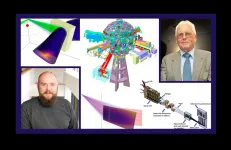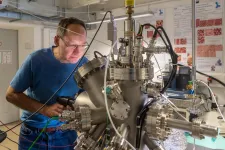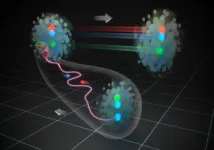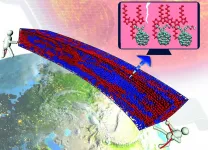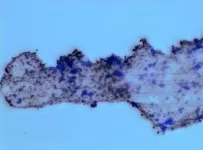New insight into biosynthesis and architecture of photosynthetic membranes in bacteria
2021-06-10
(Press-News.org) A new study conducted by the researchers at the University of Liverpool reveals how the ancient photosynthetic organisms - cyanobacteria - evolve their photosynthetic machinery and organise their photosynthetic membrane architecture for the efficient capture of solar light and energy transduction.
Oxygenic photosynthesis, carried out by plants, algae, and cyanobacteria, produces energy and oxygen for life on Earth and is arguably the most important biological process. Cyanobacteria are among the earliest phototrophs that can perform oxygenic photosynthesis and make significant contributions to the Earth's atmosphere and primary production.
Light-dependent photosynthetic reactions are performed by a set of photosynthetic complexes and molecules accommodated in the specialised cell membranes, called thylakoid membranes. While some studies have reported the structures of photosynthetic complexes and how they perform photosynthesis, researchers still had little understanding about how native thylakoid membranes are built and further developed to become a functional entity in cyanobacterial cells.
The research team, led by Professor Luning Liu from the University's Institute of Systems, Molecular and Integrative Biology, developed a method to control the formation of thylakoid membranes during cell growth and used state-of-the-art proteomics and microscopic imaging to characterise the stepwise maturation process of thylakoid membranes. Their results are published in the journal Nature Communications.
"We are really thrilled about the findings," said Professor Liu. "Our research draws a picture about how phototrophs generate and then develop their photosynthetic membranes, and how different photosynthetic components are incorporated and located in the thylakoid membrane to perform efficient photosynthesis - a long-standing question in this field."
The first author of the study, Dr Tuomas Huokko, said: "We find that the newly synthesised thylakoid membranes emerge between the peripheral cell membrane, termed the plasma membrane, and the pre-existing thylakoid layer. By detecting the protein compositions and photosynthetic activities during the thylakoid development process, we also find that photosynthetic proteins are well controlled in space and time to evolve and assemble into the thylakoid membranes."
The new research shows that the cyanobacterial thylakoid membrane is a truly dynamic biological system and can adapt rapidly to environmental changes during bacterial growth. In thylakoids, photosynthetic proteins can diffuse from one position to another and form functional "protein islands" to work together for high photosynthetic efficiency.
"Since cyanobacteria perform plant-like photosynthesis, the knowledge gained from cyanobacteria thylakoid membranes can be extended to plant thylakoids," added Professor Liu. "Understanding how the natural photosynthetic machinery is evolved and regulated in phototrophs is vital for tuning and enhancing photosynthetic performance. This offers solutions to sustainably improve crop plant photosynthesis and yields, in the context of climate change and growing population. Our research may also benefit the bioinspired design and generation of artificial photosynthetic devices for efficient electron transfer and bioenergy production."
INFORMATION:
The research was carried out in collaboration with the University's Centre for Proteome Research, Centre for Cell Imaging, and Biomedical Electron Microscopy Unit, as well as with researchers from University of Oxford, Queen Mary University of London, and Imperial College London. The research was funded by the BBSRC, Royal Society, Wellcome Trust, and Leverhulme Trust.
[Attachments] See images for this press release:
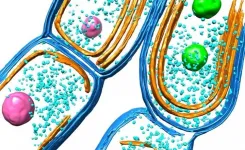
ELSE PRESS RELEASES FROM THIS DATE:
2021-06-10
Laser-produced high energy density plasmas, akin to those found in stars, nuclear explosions, and the core of giant planets, may be the most extreme state of matter created on Earth. Now scientists at the U.S. Department of Energy's (DOE) Princeton Plasma Physics Laboratory (PPPL), building on nearly a decade of collaboration with the National Ignition Facility (NIF) at the DOE's Lawrence Livermore National Laboratory (LLNL), have designed a novel X-ray crystal spectrometer to provide high-resolution measurements of a challenging feature of NIF-produced HED plasmas.
Most powerful lasers
The ...
2021-06-10
An international research team led by members from the Technical University of Munich, the Deutsches Museum, Munich, and the Swedish Linköping University has developed a method to manufacture two-dimensional polymers with the thickness of a single molecule. The polymers are formed on a surface by the action of light. The discovery paves the way to new ultrathin and functional materials.
The quest for new two-dimensional materials has rapidly intensified after the discovery of graphene - a supermaterial whose excellent properties include high conductivity and strength, making it incredibly versatile.
Two main ...
2021-06-10
WASHINGTON -- In a new study, researchers demonstrate an automated, easy-to-operate quantum key distribution (QKD) system using the fiber network in the city of Padua, Italy. The field test represents an important step toward implementing this highly secure quantum communication technology using the type of communication networks already in place in many regions around the world.
QKD offers impenetrable encryption for data communication because it uses the quantum properties of light to generate secure random keys for encrypting and decrypting data.
"QKD can be useful in any situation where security is paramount because it offers unconditional security for the key exchange process," ...
2021-06-10
Two gene variants found in African American women may explain why they are more likely to be diagnosed with triple negative breast cancer (TNBC) than white women of European ancestry, according to Weill Cornell Medicine and NewYork-Presbyterian investigators. The study findings may have implications for developing better risk assessment tools for TNBC in African American women and for understanding why they have poorer TNBC outcomes.
In a study, published April 29 in Scientific Reports, the investigators found that a version of the ANKLE1 gene that can be protective against TNBC is less likely to be found in African American women than white women of European ancestry. In addition, African American women with a mutation in the Duffy gene, which plays a role in inflammation, ...
2021-06-10
Inside each proton or neutron there are three quarks bound by gluons. Until now, it has often been assumed that two of them form a "stable" pair known as a diquark. It seems, however, that it's the end of the road for the diquarks in physics. This is one of the conclusions of the new model of proton-proton or proton-nucleus collisions, which takes into account the interactions of gluons with the sea of virtual quarks and antiquarks.
In physics, the emergence of a new theoretical model often augurs badly for old concepts. This is also the case with the description of collisions of protons with protons or atomic nuclei, proposed by scientists from the Institute of Nuclear Physics of the Polish Academy of Sciences (IFJ PAN) ...
2021-06-10
Organic residues on ceramic pottery are a valuable resource for understanding medieval cuisines of Islamic-ruled Sicily, according to a study published June 9, 2021 in the open-access journal PLOS ONE by Jasmine Lundy of the University of York, UK and colleagues.
During the 9th to 12th century AD, Sicily was under Islamic rule. This transition is known to have profoundly impacted the region, and the capital city of Palermo thrived as an economic and cultural center of the Mediterranean Islamic world. But little is known about how the lives of people in the region were impacted during this important time period.
In this study, researchers examined organic residues of plant and animal products on ceramic pottery to gain insights ...
2021-06-09
Today, solar energy provides 2% of U.S. power. However, by 2050, renewables are predicted to be the most used energy source (surpassing petroleum and other liquids, natural gas, and coal) and solar will overtake wind as the leading source of renewable power. To reach that point, and to make solar power more affordable, solar technologies still require a number of breakthroughs. One is the ability to more efficiently transform photons of light from the Sun into useable energy.Organic photovoltaics max out at 15% to 20% efficiency -- substantial, but a limit on solar energy's potential. Lehigh University engineer Ganesh Balasubramanian, like many others, wondered if there were ways to improve the design of solar cells to make them more ...
2021-06-09
GRAND RAPIDS, Mich. (JUNE 8, 2021) -- Chronic inflammation in the gut may propel processes in the body that give rise to Parkinson's disease, according to a study by scientists at Van Andel Institute and Roche.
The study, published in Free Neuropathology, is the latest in a growing list that links the gut and the immune system to Parkinson's. The researchers' findings in an experimental mouse model of gut inflammation track with several large-scale epidemiological studies that show an association between Parkinson's and inflammatory bowel diseases, such as ulcerative colitis and Crohn's disease.
Epidemiological evidence from other groups indicates the risk of developing Parkinson's fades in certain people whose ...
2021-06-09
Small pieces of plastic are everywhere, stretching from urban environments to pristine wilderness. Left to their own devices, it can take hundreds of years for them to degrade completely. Catalysts activated by sunlight could speed up the process, but getting these compounds to interact with microplastics is difficult. In a proof-of-concept study, researchers reporting in ACS Applied Materials & Interfaces developed self-propelled microrobots that can swim, attach to plastics and break them down.
While plastic products are omnipresent indoors, plastic waste and broken bits now litter the outdoors, too. The smallest of these ...
2021-06-09
TORONTO, June 9, 2021 - Researchers from York University and the University of British Columbia have found social media use to be one of the factors related to the spread of COVID-19 within dozens of countries during the early stages of the pandemic.
The researchers say this finding resembles other examples of social media misinformation ranging from the initial phase of vaccine rollout to the 2021 Capitol riot in the United States.
Countries with high social media use leading to off-line political action prior to the pandemic, as surveyed before the pandemic by V-Dem (a database from the University of Gothenburg), showed ...
LAST 30 PRESS RELEASES:
[Press-News.org] New insight into biosynthesis and architecture of photosynthetic membranes in bacteria

